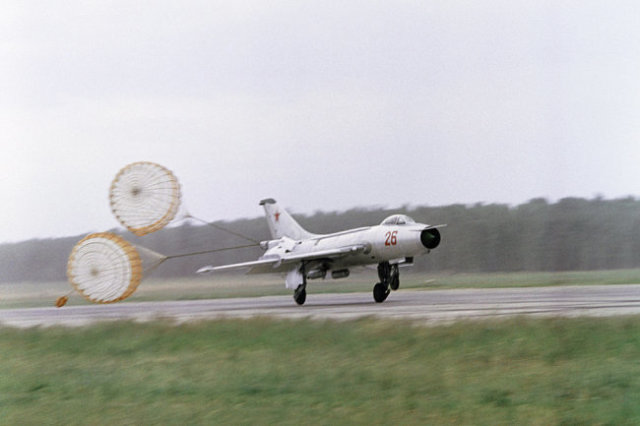55 years ago, on February 13, 1967, an air incident occurred that could cause great damage to the Soviet Air Force. But the Soviet pilot did not lose his head and everything ended well.
In those days, the four fighters of the newest and then still secret modification of the MiG-21 PFM had to be driven from the Soviet factory to the airfield in the GDR - to replenish the allied aviation under the Warsaw Pact. The team of distillers was led by an experienced pilot, Captain Fyodor Grigoriev, who served in the 16th Air Division of the 24th Air Army of the Group of Soviet Troops in Germany (GSVG). According to the assignment, the planes were planned to be delivered to the military airfield of the GDR army Kottbus. By the way, Grigoriev had previously flown to another airfield (Templin), and this route was not familiar to him. Which soon had the most unexpected effect.
Berlin at that time was divided into two zones: the Eastern one was controlled by Soviet troops, and the Western one by NATO troops. It was difficult to determine the invisible border from the air, so four MiGs (according to other sources there were five of them) accidentally flew into the western part of the city. Seeing the airfield under him, which he mistook for a Cottbus, Fyodor Grigoriev informed the other pilots that he would land. At the same time, he ordered his subordinates to remain in the air until his special order. The fact is that the attempt to contact the "tower" of the airfield ended in vain, and Grigoriev decided that communication had failed there. He made the decision to sit down at his own risk.
After landing, the captain quickly realized his mistake: he saw NATO equipment - French and American, and personnel in "alien" uniforms. It turned out that this was the Tegel airfield of the French occupation zone. Grigoriev urgently threw out the braking parachute and began to turn around for takeoff. But the NATO members also saw what kind of "bird" flew to them, and were going to hijack the plane. To do this, they drove all the vehicles of the airbase to the runway (runway). Grigoriev noticed this maneuver and turned the Mig onto the taxiway. It was actually not suitable for takeoff - it was too short. But the Soviet pilot was not at a loss: on the run-up, he turned on the afterburner and managed to get away with an almost vertical "candle".
The other pilots realized what was going on and changed course. Soon they flew safely to the Cottbus airfield. Their commander also arrived there.
Naturally, the investigation began. After all, it could have ended badly: the MiG-21 PFM had the latest electronic sight, a new fire control system, and an ejection seat of the latest modification. All this would be thoroughly studied by NATO specialists - both in search of advantages and possible vulnerabilities. Captain Grigoriev was facing serious punishment.
But everything ended well: the division command decided not to punish the pilot, who had a lot of merit. In the end, he got himself out of the situation, and even showed courage and skill at the same time.
By the way, now versions are being put forward that Grigoriev could have mistaken the signal of the radio beacon of the Tegel airfield for the signal of the Cottbus lighthouse. They claim that they sounded very similar.
Oleg Galitsky

